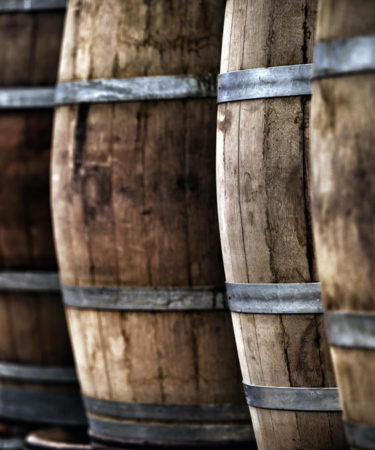What’s on your mind when you sip your favorite Scotch, bourbon, or whiskey? Politics, maybe? Philosophy? A funny Tweet you read on your phone just now?
Few of us spend cocktail hour contemplating wood, but it’s impossible to overstate its importance in the production and taste of brown spirits. Dan Szor, CEO and founder of Cotswalds Distillers, estimates wood is responsible for 60 to 75 percent of the taste of a finished whiskey.
“Wood is known for its ability to ‘take out the bad’ through evaporation,” Szor says, “and ‘put in the good’ through extraction of tannins and wood sugars.”
A whiskey that has not spent enough time in the barrel will exhibit too much “spiritiness,” Szor says, or be overly sharp. It might also present off-notes on the nose and palate.
Wood affects what Szor calls “feinty notes” such as solvent, turpentine, and meatiness in spirits. “There is also the flavor imparted by previously held liquids,” Szor says, such as bourbon or sherry.
The Macallan has its own “Master of Wood.” His name is Stuart MacPherson and he shepherds chosen woods through the sherry seasoning process in Jerez, Spain, all the way to the aging process in Scotland.
“A lot of companies will just buy casks,” MacPherson says. “They’re on the open market. They’re readily available.” The Macallan, however, is so obsessed with wood that MacPherson visits the cooperages and sherry bodegas to ensure the process is running smoothly.
Wood “is one of just four raw ingredients in single malt whiskey, the others being barley, yeast, and water,” Westland Distillery blender Shane Armstrong says.
Once they’ve gotten the right wood, skillful distillers treat it with care to impart certain flavors to spirits.
“I would say that toasting temperatures is slightly more of a priority,” says MacPherson. Toasting develops sweet, warm, and woodsy notes from the barrel. Heat breaks down certain chemical compounds in the wood that start to release the sugars that provide desirable flavors.
“It generally comes down to strength and porosity,” MacPherson adds.
Oak is the most commonly used wood not just in Scotch whisky and American bourbon, but also the wine industry.
“Because of its primary role, aging in oak is often seen as the one true bellwether of quality,” Shane Armstrong, Westland Distillery blender, says.
Below are the five types of oak most commonly used, as well as woods distillers avoid.
Commonly Used Types of Oak
Quercas Alba (White American Oak)
American oak is particularly good for aging spirits due to its relatively small and tight grain, which releases tannins more slowly than its European counterparts. “This means that whisky can be aged for longer, without becoming over-woody and is particularly important in warmer climates such as Kentucky, or in Asia,” says Szor.
“American oak is higher in vanillin and oak lactones which we feel complements rye whiskey,” Bruce Joseph, master distiller, Hotaling & Co., says.
American Oak barrels are typically charred on the inside by briefly setting them on fire. That char helps open up the pores so the spirit can more easily enter the wood. “It also caramelizes the wood sugars, which is partially responsible for the vanilla, crème brûlée, and honey notes found in many bourbons,” Szor adds.
Quercas Petraee (Sessile European Oak)
Unlike the sweet flavors of white American oak, Sessile European oak provides a high level of tannins and darker, spicier notes. High West master distiller Brendan Coyle calls this “oak spice. Think low-level peppercorns and potpourri.”
Quercas Robur (Penduncate European Oak)
This European oak provides more wood structure and tannins more quickly than other types. “It is the wood usually used for aging sherry, port, and many European wines” Szor says, “So these barrels will also impart fruity notes, due to the several liters of wine previously absorbed into the wood.”
Red fruit, berries, peach, Seville orange, and apricot notes are found in spirits aged in ex-red wine casks. Sherry and port or Madeira casks will impart more dried fruit flavors, such as raisins, figs, and fruit cake. These are prized by fans of single malts.
Quercas Mongolica (Japanese Mizunara Oak)
“In Japan, Mizunara oak is commonly used to age whisky and imparts a very specific flavor profile,” Szor says. Mizunara oak has a higher moisture content than most other oaks used for whiskey. It’s also much more porous and imparts flavors like vanilla, honey, dried fruits, and cloves.
Quercas Garryana (Garry American Oak)
“One of the more exciting oak species we work with is a native oak called Quercus garryana, or Garry oak,” Armstrong says. “This is a species of white oak only found in a narrow band of the Pacific Northwest stretching from southern B.C. down to Northern California.”
Garry American oak is a new favorite of many distillers because it imparts distinctly dark, complex notes. Molasses, clove, smoke, and coffee grounds are among its rich, spicy flavors.
Woods Not Good For Aging
Although other woods like chestnut, maple, acacia, and cherry can and have been used for aging spirits, they are not allowed under the Scotch Whisky Association’s rules for Scotch whisky. There is therefore limited demand for and even smaller supply of these barrels.
“In the past, chestnut was used,” says MacPherson. “But it’s extremely hard to work with. It’s extremely porous.”
Typically, the woods that are considered “bad” for aging are woods that lack a certain structural integrity. That leads to leaking and higher losses. “Maple wood is a good example of this,” Coyle says. “It’s produced good whiskies but losses tend to be higher.”
